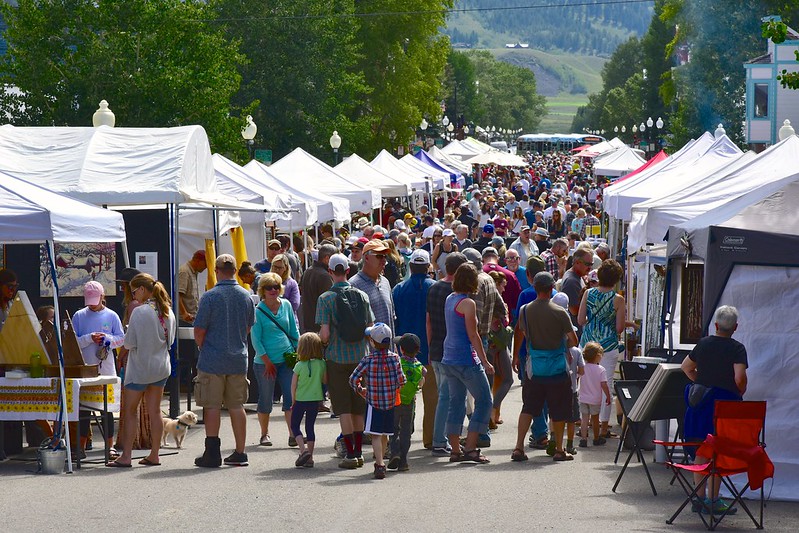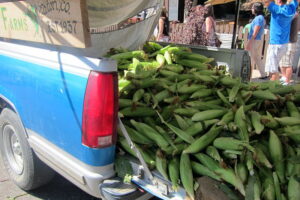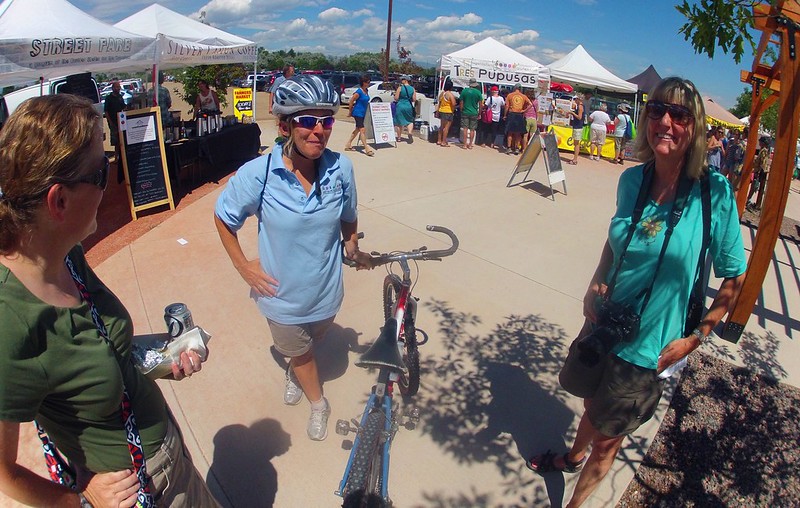
Agriculture is big in Colorado, and a recent survey from the Colorado Department of Agriculture shows that Coloradans care a lot — not only about how their food is grown, but where it’s grown.
More than 80% of respondents to the 2022 Public Perceptions and Attitudes about Colorado Agriculture survey said seeing that an item was grown or raised in Colorado was most likely to influence their decision as to whether or not to buy a product. That’s great news for marquee brands like Palisade peaches, Pueblo chiles and Rocky Ford melons, but it’s also great for the industry as a whole.
Dawn Thilmany is an agricultural economist and professor with CSU’s Department of Agricultural and Resource Economics. She’s also the director of the new Northwest and Rocky Mountain Regional Food Business Center and the co-director of CSU’s Regional Economic Development Institute.
Thilmany spoke with The Audit about the survey results and what they tell us about the impact of agriculture in Colorado and the “buy local” movement.
This transcript has been lightly edited for clarity.
Hi Dawn, thanks for being here.
Hi, I’m excited to talk about this.
We’re heading into prime farmers market season with some of the premier crops like Palisade peaches and Olathe sweet corn. How did the “buy local” movement become so important in Colorado, and how has it impacted Colorado agriculture?
It’s a great question. I feel like I’ve gotten to grow up with this sector because it really started about when my career started 25 years ago. We’d always seen farmer’s markets take shape across communities in Colorado, but we really saw an increased attention and interest in farmers markets starting a couple of decades ago.
When we talk to consumers about what interests them, not all consumers are the same. For some people, they really notice a quality difference. For some crops, that makes a lot of sense, like fresh fruits such as sweet corn and peaches. For others, they say it’s a sense of paying into their economy and their community. They know the farmers they’re meeting. They see the land that they’re stewarding, and they want to make sure that they’re still here for the next generation. And yet for others, they see it almost as an environmental win, they know supporting those local goods makes sure there are still those farms and ranches that often provide the open spaces they have as their viewscapes and recreate in.
So really, depending on the consumer, you might have an entirely different answer. But all of those forces coming together have made it a strong and growing movement.

Have you seen that impacting agriculture in general? What’s been the benefit?
The biggest changes we’ve seen affect agriculture in the most visible ways are, of course, we used to have a more homogeneous set of farmers, and by that, I mean a lot of them did about the same thing.
What we’ve really seen now is different populations of producers break off. Some are still very much doing the same thing they’ve done for a century, mostly looking at national or export markets for the products.

But then there’s other producers who have found either they had a real talent for customer service, or they never wanted to be as big as you need to be for national markets. They’ve broken off and just like we saw in the craft beer industry, they kind of became our “craft food” producers. They spent more of their time not just on producing food, but also making venues, markets, sometimes even agritourism that actually fully embedded a customer experience alongside selling food.
Another dimension that we’ve really seen is other institutions looking at how they can bring local food into spaces whether it’s the farm-to-school movement and people wanting to see products grown around them in their school lunches, or it’s King Soopers wanting one part of their produce case to be all Colorado grown. We’re even seeing more food companies start up.
Craft brews are the most popular, but we’re now seeing craft bakeries that feature grains from Colorado, and we’re seeing craft butcher shops which only carry Colorado meat. So, we’re seeing little tentacles where this interest in local foods is almost changing the structure of how some households buy and eat food.
In the survey, 83% of Coloradans reported that knowing a food product was grown or raised in Colorado influenced their purchasing decision when shopping or dining out even more than terms like organic or gluten free. Why is being locally produced such an important element in purchasing agricultural products for Colorado consumers?
For the quality dimension of course: There are products which we have scientific evidence lose some of their nutrients and eating quality the longer they are from harvest, particularly you mentioned peaches, sweet corn and melons. And so, I think there’s a big win in some people’s minds just because they know they’re getting it at its freshest, best point of eating quality. I think that’s how this started.

But now it’s become almost like a marketing relationship. People have their personal farmers that they like to go have a talk with at the farmers market or they stop by their stand or there’s even towns in Colorado that have festivals based off the product that they’re highlighting. Loveland still has a sweet corn festival.
I think it’s almost become a community building or cultural pride of product in what’s from their part of the state. Pueblo chiles is the most nascent here. We’ve seen the biggest growth there.
And then, I think last of all is again, just like people love our Colorado flag, there’s just this weird essence in Colorado, a lot of state pride.
I think it just translates to food, because when it comes down to it, it’s the most frequent decision we really make as humans because we tend to make it one to three times a day. So, it being top of mind is great for our industry.
I think producers would tell you it’s been a little harder to navigate because for all the interest in eating local, people still do have their habits, and they have this tendency to want to go to a grocery store once a week or to the restaurants they want to go to. So, when our producers can’t quite get their products into exactly the right places, we fall short because farmers markets can’t carry all this. But we’re continuing to see innovative ways producers are getting their product in front of Colorado consumers as much as possible.
Is this unique to Colorado or is this something that we’re seeing across the country?
We have seen a local and regional food system movement across the entire country, and almost every state has a state brand like our Colorado Proud label. But when there’s been surveys done on this, we have probably the best brand recognition of any state seal in the country, which is a testament to the great

job Colorado Proud has done.
It oddly even fits with both our outdoor culture — because farmers markets are an outdoor way to recreate — but also our tourist culture. Some people, even when they’re tourists here, come to our farmers markets.
We like to even think it might have some connection with the craft brew industry. We were one of the big players in that too, and people just looking for something different than average and a lot of different foods now have benefited from people looking for that.
One of the things that I thought was interesting in the survey results was that the top five products that respondents mentioned as being grown or raised in Colorado, were corn, peaches, wheat, beef and cantaloupe.
Well, it’s interesting. It’s mixed because three of those crops are very big sales leaders for our state, cattle being, of course, the dominant one. Whereas peaches and melons aren’t really that big in sales. They’re just so visible when they’re in season, and they’re two of those that the eating quality — some people would argue — is at its best when it’s fresh picked. So, having it local means a lot.
Then you flip to wheat and beef, and I think there that’s a lot more about people envision as they drive the roads of Colorado. Those are the kinds of farms that are keeping large landscapes as undeveloped viewscapes that are part of what they want to believe their Colorado is. Because in the same survey we saw most Coloradans say agriculture is part of their quality of life here. I think that’s because some of them came from more concentrated, developed areas and they love the fact that you can get outside of our cities and there’s wide open spaces. Agriculture makes a lot of that possible.
It’s interesting because that survey, as you mentioned, showed overwhelming agreement — I think it was like 98% — as to the importance of Colorado’s food and agricultural industry, not only to economic development but to that quality of life you were talking about. What does that tell you about the status of the industry? And why is a survey like this important?
First, it’s very reaffirming because we obviously do this with the Department of Agriculture because the bread and butter of CSU’s agricultural college and the Colorado Department of Agriculture is knowing that we have the public wanting to make investments in this space.
We have started new programs in both government and universities, starting with the government. They’ve had the Colorado Proud program since I’ve been here, over 25 years. This kind of confirms to them that’s done its job of getting our products visibly in front of our consumers who have all those buying dollars in the food markets. And it’s having perhaps an effect on the bottom line or the number of farms and food businesses that survive because they have those markets.
Some of their newest investments have been in climate smart agriculture programs. But again, these results also confirm that the respondents think it’s appropriate to use public dollars to make sure we have farms going forward. So, it gives them reassurance that their public dollars are being invested appropriately for what the public wants.

Similarly, we at CSU have had a Food Systems team for about 20 years, and now we have this new food business center grant. It was pretty confirming that that was the right direction and investment to go in when our population is telling us they want more. We’re coming alongside the Colorado Department of Agriculture with some of these climate smart programs. Gene Kelly is leading a new climate roadmap for the entire USDA.
It tells us again that the public is there. What we want to believe about Colorado is we’re not that unlike the rest of the United States, but we’ve tended to be early adopters. We’re three, five, 10 years ahead of when the rest of the country decides they really want to invest and be in a space. We like to think of ourselves as early indicators. So, of course, it’s important for us to deliver on these investments and promises well, so that we’re setting the stage for the whole country to follow behind us and learn from what we did well and improve on what we could have done better.
It’s been a fun place to work at Colorado State because of that, because we’ve had our public so behind us in thinking these are important problems. We’re just excited that we have such a strong partnership with the Colorado Department of Agriculture that they’ve let us come alongside them to do these surveys.
We’re now in our 30th year of tracking this for Colorado consumers. You have a lot of conversations with a lot of people where you think you know that you’re working on important problems, but to have a representative sample of Coloradans tell you that the issues that you’ve chosen to focus on, make policies around, do research in and teach on are what’s top of mind for them is really reaffirming to public institutions, like the government and the universities. So, we’re glad our Department of Agriculture had the foresight to frame a survey like this and that we’ve continued it for so many years. It’s been a great partnership.